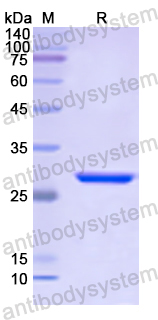Catalog No.
YHF02501
Expression system
E. coli
Species
Homo sapiens (Human)
Protein length
Thr569-Ile807
Predicted molecular weight
28.55 kDa
Nature
Recombinant
Endotoxin level
Please contact with the lab for this information.
Purity
>90% as determined by SDS-PAGE.
Accession
P54253
Applications
ELISA, Immunogen, SDS-PAGE, WB, Bioactivity testing in progress
Form
Lyophilized
Storage buffer
Lyophilized from a solution in PBS pH 7.4, 0.02% NLS, 1mM EDTA, 4% Trehalose, 1% Mannitol.
Reconstitution
Reconstitute in sterile water for a stock solution. A copy of datasheet will be provided with the products, please refer to it for details.
Shipping
In general, proteins are provided as lyophilized powder/frozen liquid. They are shipped out with dry ice/blue ice unless customers require otherwise.
Stability and Storage
Use a manual defrost freezer and avoid repeated freeze thaw cycles. Store at 2 to 8°C for frequent use. Store at -20 to -80°C for twelve months from the date of receipt.
Alternative Names
ATXN1, SCA1, ATX1, Spinocerebellar ataxia type 1 protein, Ataxin-1
Accurate Quantification of Mutant and Wild-Type polyQ Proteins Using Simple Western Capillary Immunoassays., PMID:40450087
Fingolimod Prevents Neuroinflammation but Has a Limited Effect on the Development of Ataxia in a Mouse Model for SCA1., PMID:40429839
An expanded polyglutamine in ATAXIN1 results in a loss-of-function that exacerbates severity of Multiple Sclerosis in an EAE mouse model., PMID:40321775
An expanded polyglutamine in ATAXIN1 results in a loss-of-function that exacerbates severity of Multiple Sclerosis in an EAE mouse model., PMID:40307815
Sex Differences in a Novel Mouse Model of Spinocerebellar Ataxia Type 1 (SCA1)., PMID:40141263
Transcriptional repressor Capicua is a gatekeeper of cell-intrinsic interferon responses., PMID:40132591
Natural compounds as therapeutic candidates for spinocerebellar ataxia type 1: a computational approach., PMID:40098751
Prediction of protein interactions with function in protein (de-)phosphorylation., PMID:40029919
Comparison of Molecular Testing Methodologies for CIC-Rearranged Sarcomas., PMID:39985394
Revisiting huntingtin activity and localization signals in the context of protein structure., PMID:39973382
Targeting AXL Inhibits the Growth and Metastasis of Prostate Cancer in Bone., PMID:39879384
[Central nervous system sarcoma with ATXN1::DUX4 fusions: report of a case]., PMID:39863538
ATXN10 Gene Expansions in Mexican Patients with Ataxia Without Epilepsy., PMID:39820777
The capicua-ataxin-1-like complex regulates Notch-driven marginal zone B cell development and sepsis progression., PMID:39632849
Enhanced Age-Dependent Motor Impairment in Males of Drosophila melanogaster Modeling Spinocerebellar Ataxia Type 1 Is Linked to Dysregulation of a Matrix Metalloproteinase., PMID:39596808
Dysregulation of alternative splicing is a transcriptomic feature of patient-derived fibroblasts from CAG repeat expansion spinocerebellar ataxias., PMID:39589088
Mutation Screening of ATXN1, ATXN2, and ATXN3 in Amyotrophic Lateral Sclerosis., PMID:39496878
Increased intrinsic membrane excitability is associated with olivary hypertrophy in spinocerebellar ataxia type 1., PMID:39475127
Identification and Copy Number Variant Analysis of Enhancer Regions of Genes Causing Spinocerebellar Ataxia., PMID:39456985
CIC/ATXN1-rearranged tumors in the central nervous system are mainly represented by sarcomas: A comprehensive clinicopathological and epigenetic series., PMID:39442927
Expanded ATXN1 alters transcription and calcium signaling in SCA1 human motor neurons differentiated from induced pluripotent stem cells., PMID:39307401
Early-onset phenotype in a patient with an intermediate allele and a large SCA1 expansion: a case report., PMID:39289638
A Neural Basis for Mutant ATAXIN-1 Induced Respiratory Dysfunction in Mouse Models of Spinocerebellar Ataxia Type 1., PMID:39229230
Construction and validation of a synthetic phage-displayed nanobody library., PMID:39198226
PQBP3 prevents senescence by suppressing PSME3-mediated proteasomal Lamin B1 degradation., PMID:39103492
Differential microRNA expression in the SH-SY5Y human cell model as potential biomarkers for Huntington's disease., PMID:39049823
Cerebellar contribution to cognitive deficits and prefrontal cortex dysfunction in Spinocerebellar Ataxia Type 1 (SCA1)., PMID:39026827
Evaluating the expression pattern of ATXN1 and CDC42EP1 genes and related long noncoding RNAs in oral squamous cell carcinoma., PMID:39002033
MUC5AC immunoreactivity in scattered tumor cells is useful for diagnosing CIC-rearranged sarcoma., PMID:38970674
Tracking longitudinal thalamic volume changes during early stages of SCA1 and SCA2., PMID:38954239
Cerebellar Heterogeneity and Selective vulnerability in Spinocerebellar Ataxia Type 1 (SCA1)., PMID:38750673
CAG repeat mosaicism is gene specific in spinocerebellar ataxias., PMID:38626762
Clinical and genetic features of dominant Essential Tremor in Tuscany, Italy: FUS, CAMTA1, ATXN1 and beyond., PMID:38626532
Dynamic molecular network analysis of iPSC-Purkinje cells differentiation delineates roles of ISG15 in SCA1 at the earliest stage., PMID:38594382
PGT-M for spinocerebellar ataxia type 1: development of a STR panel and a report of two clinical cases., PMID:38578603
Memantine suppresses the excitotoxicity but fails to rescue the ataxic phenotype in SCA1 model mice., PMID:38574621
Targeted degradation of hexokinase 2 for anti‑inflammatory treatment in acute lung injury., PMID:38516767
Mapping SCA1 regional vulnerabilities reveals neural and skeletal muscle contributions to disease., PMID:38512434
Quantitative Evaluation of Stance as a Sensitive Biomarker of Postural Ataxia Development in Preclinical SCA1 Mutation Carriers., PMID:38492164
Diagnostic uplift through the implementation of short tandem repeat analysis using exome sequencing., PMID:38308084
Beyond C9orf72: repeat expansions and copy number variations as risk factors of amyotrophic lateral sclerosis across various populations., PMID:38254109
Intranuclear inclusions of polyQ-expanded ATXN1 sequester RNA molecules., PMID:38125008
Longitudinal single-cell transcriptional dynamics throughout neurodegeneration in SCA1., PMID:38016472
HD and SCA1: Tales from two 30-year journeys since gene discovery., PMID:37863037
Functional implications of paralog genes in polyglutamine spinocerebellar ataxias., PMID:37845370
Antagonistic roles of canonical and Alternative-RPA in disease-associated tandem CAG repeat instability., PMID:37827155
Dysregulation of alternative splicing in spinocerebellar ataxia type 1., PMID:37802886
Altered calcium signaling in Bergmann glia contributes to spinocerebellar ataxia type-1 in a mouse model of SCA1., PMID:37802154
Stem cell antigen-1+cell-derived fibroblasts are crucial for cardiac fibrosis during heart failure., PMID:37740736

